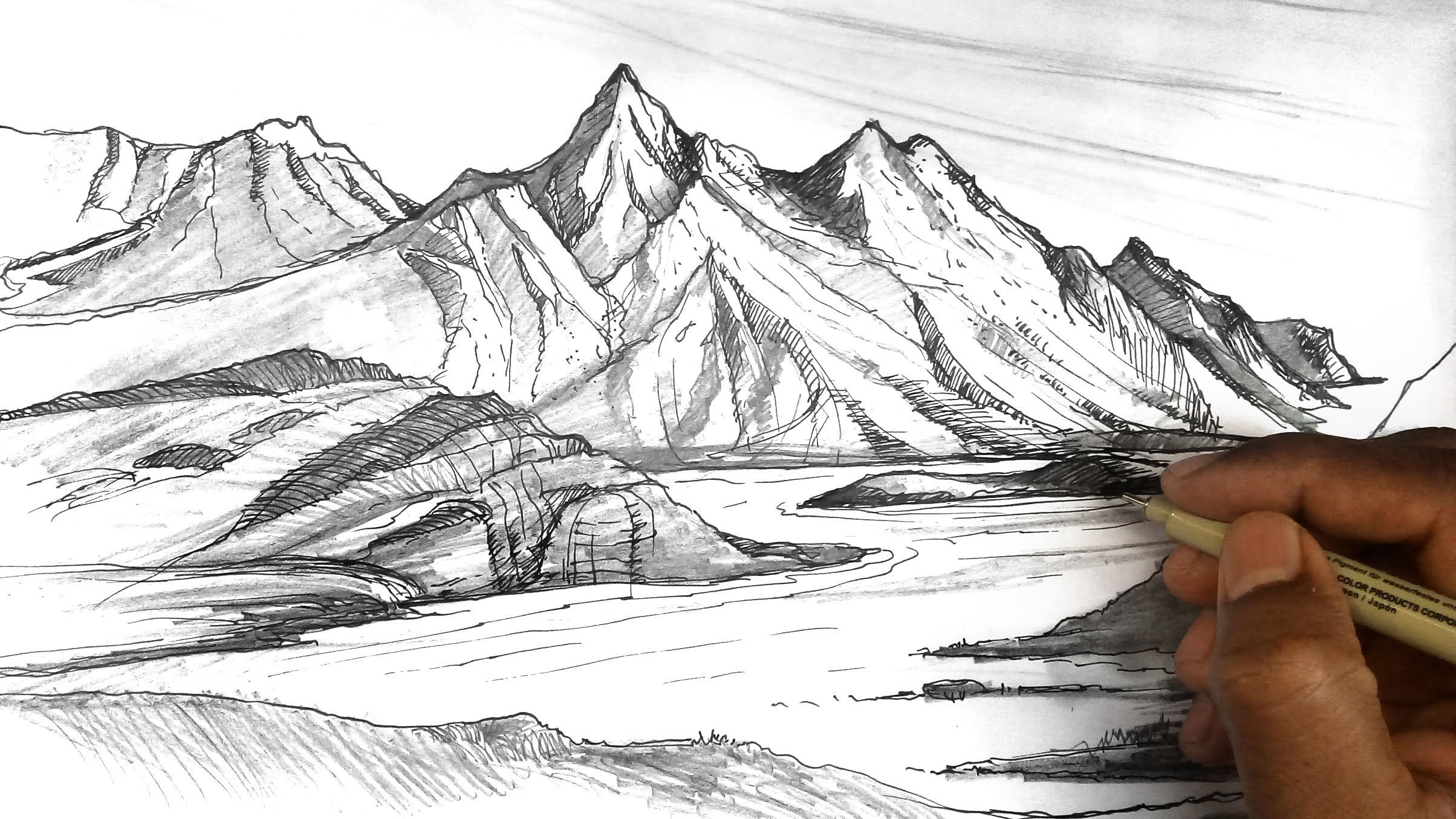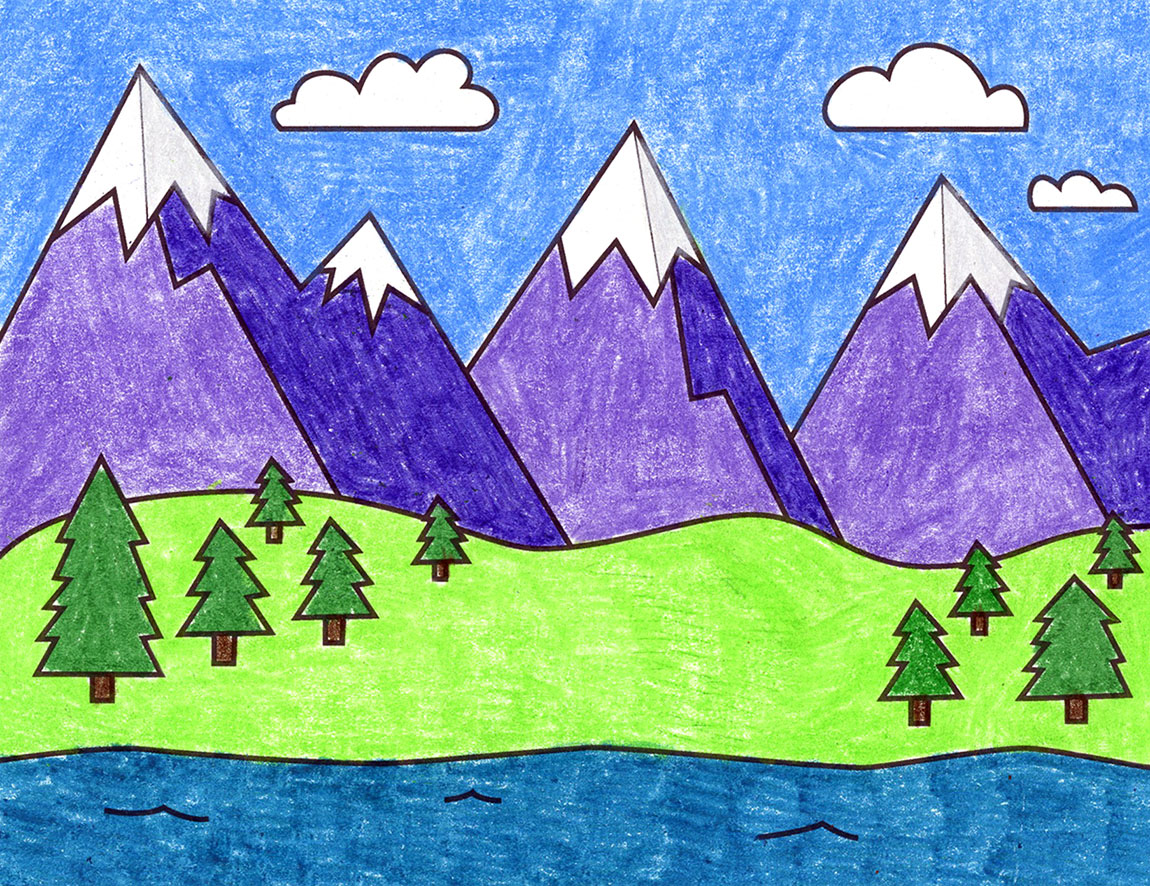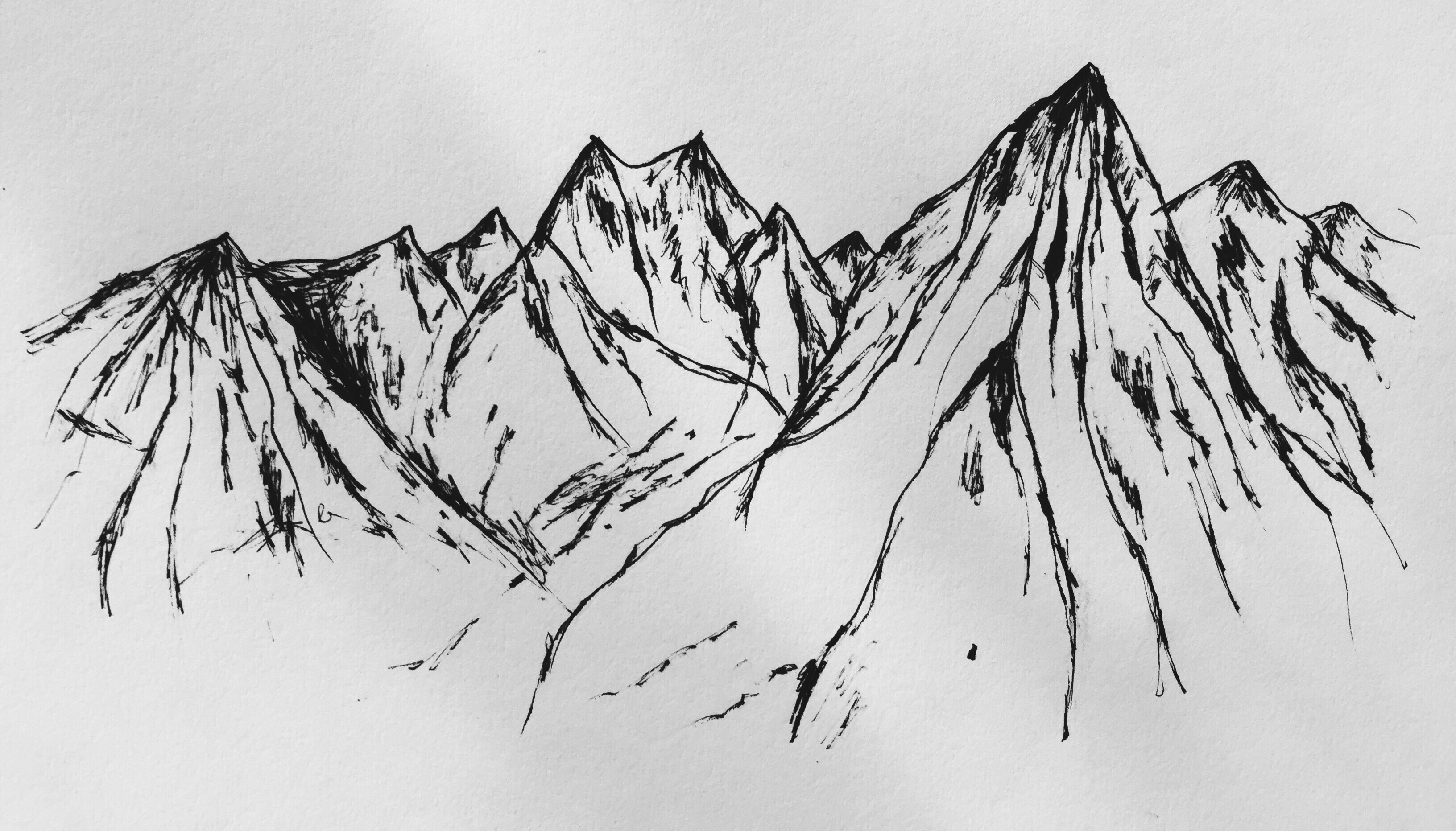Mountains Drawing - Simple Steps For Stunning Scenery
Humanized Version
Have you ever felt a little pull to put pencil to paper, maybe to capture the quiet power of a grand mountain range? It’s a feeling many of us share, that wish to make something beautiful, something that shows a wide open space. Creating a picture of a mountain is, in fact, a rather straightforward and simple thing to do, a really good visual aid for making scenes that suggest huge distances. These sorts of pictures, you know, they can truly set the stage for any outdoor scene you might want to bring to life.
So, if you’ve ever wondered how to get those majestic peaks onto your page, you’re in the right spot. This little guide, you see, is all about showing you how to put those impressive shapes down. We'll look at how to get the general shape of a mountain scene, starting from just a few lines. It’s pretty amazing what you can do with just a pencil and a bit of paper, and we'll walk through it all, step by step, to help you feel good about what you are doing.
This whole idea of making mountain pictures is, actually, for anyone who wants to try their hand at drawing, whether you're just starting out or you've been sketching for a while. We’ve got some really easy ways to approach it, with simple ideas and clear steps. You'll find ways to create these grand scenes, and you'll get a feel for how light plays on shapes, making your pictures look more real. It's truly a fun way to get creative and see what you can make.
Table of Contents
- Why try your hand at mountains drawing?
- What makes mountains drawing so approachable?
- How can mountains drawing help your art skills?
- Getting Started with Mountains Drawing
- Simple Techniques for Mountains Drawing
- Where can you find inspiration for mountains drawing?
- Adding Depth and Realism to Mountains Drawing
- Mountains Drawing - Ideas for All Skill Levels
Why try your hand at mountains drawing?
You know, there's something truly special about putting a mountain onto paper. It’s a way to bring a piece of the big outdoors right into your home, or just to create a sense of wide open space in your art. A picture of a mountain, you see, can give a feeling of how far away things are, making your scenes look like they go on and on. It’s a pretty neat trick for anyone wanting to add that kind of scope to their artwork, and it’s a skill that builds on itself, too it's almost like learning a secret language for showing distance.
For many people, the idea of drawing something as grand as a mountain might seem a bit much, but it’s actually a really calm and enjoyable pastime. It lets you focus, just a little, on the shapes and forms that nature puts out there. Plus, it’s a wonderful way to express yourself, to show what you see and feel about those impressive landforms. It really is a simple way to create something that feels big and open, and that’s a pretty cool thing to be able to do, don't you think?
Think about it: a picture of a mountain can tell a story without any words. It can suggest adventure, quiet reflection, or just the pure, untouched beauty of the natural world. So, taking the time to learn how to put these shapes down is more than just learning a drawing trick; it’s about learning to speak through your art. It’s a way to connect with the world around you, and that, is that, a pretty good reason to give it a go.
What makes mountains drawing so approachable?
One of the nicest things about making pictures of mountains is just how simple it can be to get started. You don't need a whole lot of fancy art supplies or years of practice. Really, all you need is something to draw with and something to draw on. The basic shapes of mountains are, in a way, quite forgiving. They don't have to be perfect; nature itself is full of rough edges and unique forms, so your drawings can be, too.
This kind of picture-making, you know, it’s often broken down into steps that are very easy to follow. We’re talking about drawing a few lines here, adding a bit of shading there, and before you know it, you’ve got something that looks like a mountain. It’s not about being a master artist right away; it’s about taking those small, manageable steps. That’s why, for instance, many people find it such a good starting point for their creative adventures.
And what’s really good is that there are so many ways to learn. You can find simple guides, pictures to copy, or even videos that show you exactly what to do. It’s very much a "follow along and see what happens" kind of activity. So, if you’ve ever felt like drawing was too hard, or that you weren't "artistic enough," this kind of picture-making might just change your mind. It’s pretty much for everyone, actually.
How can mountains drawing help your art skills?
Making pictures of mountains is more than just creating a pretty scene; it’s a fantastic way to pick up some really important art skills. For one thing, it teaches you a lot about how light and shadow work. Mountains, with their peaks and valleys, show these effects in a very clear way. When the sun hits a mountain, some parts are bright, and others fall into darkness, and learning to show that on paper gives your pictures a real sense of form. It’s a basic principle that applies to pretty much all kinds of drawing, you know.
Also, working on mountains drawing helps you get better at creating a sense of distance and depth. When you draw a mountain range, you naturally start to think about how things look when they are far away versus close up. This means playing with how light or dark things are, how clear the lines are, and even how much detail you put in. It’s a really practical way to learn about perspective, which is a big part of making realistic-looking scenes. So, it's not just about the mountains, but about seeing the world in a new way, in some respects.
Plus, this kind of drawing gives you practice with different textures. Rocks, snow, trees – mountains have all sorts of surfaces, and trying to show those different feels on paper makes your hand more skilled. You learn to make rough marks for rocks, soft marks for snow, and so on. It’s a good workout for your drawing hand, basically, and it helps you feel more comfortable with your tools. It truly helps build up a good set of drawing abilities.
Getting Started with Mountains Drawing
To begin making pictures of mountains, you don't need anything too complicated. A pencil, an eraser, and some paper are really all that's required. The key is to start with the overall shape, the general outline of the mountain scene you want to create. Think of it like mapping out the biggest forms first, before you get into any smaller bits. This simple approach helps you get the main idea down without getting lost in too much detail right at the start. It's a way to build confidence, you know, as you put down those first few lines.
Many guides suggest starting with a few simple lines to mark where the peaks will be and how they connect. You might sketch a kind of wavy line across your paper to show the top edge of your mountain range. Then, you can add lines going down from those peaks to show the sides of the mountains. It's a bit like drawing a series of triangles, but with softer, more natural curves. This first step is just about getting the general feel of the scene, not about making it perfect. It’s pretty much about getting the main idea on the page, more or less.
Once you have those basic outlines, you can begin to refine them. You might add a few more bumps or dips to make the shapes look more natural and less like simple geometric forms. Remember, no two mountains are exactly alike, so your drawing doesn't need to be perfectly smooth or even. This early stage is all about getting comfortable with the overall shape and presence of your mountains drawing, before you add any of the more intricate parts. It’s truly a good way to begin any sort of picture-making, to be honest.
Simple Techniques for Mountains Drawing
When you're making pictures of mountains, there are a few straightforward ways to make them look really good. One common technique is to think about the different layers of mountains. The ones closest to you might have more detail and appear darker, while those farther away will look lighter and hazier. This simple trick helps create a sense of deep space in your mountains drawing. It’s a pretty effective way to make your scene feel like it goes on for miles, you know.
Another helpful method involves using simple lines to suggest cracks, ridges, or snow patches. You don't have to draw every single rock; instead, use a few well-placed lines to give the idea of rough surfaces. For instance, a series of short, broken lines can suggest a rocky face, while smoother, flowing lines might hint at snow. This kind of shorthand makes your drawing interesting without requiring you to spend hours on tiny details. It’s really about suggesting, rather than spelling out, every little thing, which is a good skill to pick up, frankly.
And when it comes to adding a bit of life to your mountains drawing, consider the overall mood. Is it a sunny day, or is there a bit of mist? These things can be shown with how you use your pencil. Lighter pressure for soft clouds, darker pressure for sharp shadows. It’s just about playing around with your tools and seeing what kind of feeling you can create. This kind of experimentation is actually a lot of fun, and it really helps your pictures come alive, too.
Where can you find inspiration for mountains drawing?
Finding ideas for your mountains drawing is, honestly, all around you. You don't have to go on a big trip to a mountain range, though that would be pretty cool. You can look at photographs, watch nature shows, or even just search online for pictures of mountains. There are so many different kinds of peaks, from jagged, pointy ones to more rounded, rolling hills, and each one offers a unique shape to explore. It’s pretty much an endless source of ideas, if you think about it.
Also, consider looking at other artists' work. See how different people have approached making pictures of mountains. You might find ideas for how to use light, how to show texture, or even how to simplify complex shapes. It's not about copying exactly, but about seeing what catches your eye and thinking about how you might try something similar in your own way. This kind of looking can really spark your own creative thoughts, you know, and help you develop your own personal style.
Sometimes, the best inspiration comes from just letting your mind wander. Close your eyes and imagine a mountain scene. What kind of weather is it? What time of day? Is there snow? Are there trees? These mental pictures can be a great starting point for your mountains drawing, giving you a personal connection to what you're creating. It’s a bit like daydreaming with a purpose, and it can lead to some really unique and heartfelt art, too it's almost a kind of meditation, in a way.
Adding Depth and Realism to Mountains Drawing
To make your mountains drawing truly pop and feel like it has real depth, one of the most important things is to work with light and shadow. This isn't just about making things dark or light; it's about understanding where the light source is coming from and how it hits the different surfaces of the mountain. If the sun is coming from the left, for example, the left sides of the peaks will be brighter, and the right sides will be in shadow. This simple idea adds so much shape and form to your picture, making it look much more solid and real, you know.
You can use different levels of pencil pressure to create these light and dark areas. A very light touch for the sunlit parts, and gradually increasing pressure for the shaded areas. You might also use a blending tool or even your finger to soften the edges of the shadows, making them look more natural and less harsh. This kind of careful shading really brings out the bumps and hollows of the mountain, giving it a three-dimensional feel. It’s pretty much what makes a flat drawing look like it has actual form, basically.
Beyond light and shadow, adding texture is another way to make your mountains drawing feel more real. Think about the different surfaces: rough rock, smooth snow, perhaps some patches of trees. You can use different kinds of marks to suggest these textures. Short, choppy lines for rocky parts, soft, even strokes for snow, or little scribbles for distant trees. These small details, when put together, create a rich and believable scene. It’s a bit like adding different flavors to a dish; each one makes the whole thing better, in a way.
Mountains Drawing - Ideas for All Skill Levels
Whether you're just starting out or you've been sketching for a while, there are tons of ideas for your mountains drawing. For beginners, sticking to very simple outlines and basic shading is a great way to build confidence. You could try drawing a single, simple peak with just one light source, or perhaps a gentle, rolling hill. There are even printable outlines you can trace or coloring pages that help you get a feel for the shapes without having to create them from scratch. It’s a really low-pressure way to get your hand moving, you know.
As you get a bit more comfortable, you can start to add more elements to your mountains drawing. Maybe try a range of mountains, with some closer and some further away, playing with that sense of distance. You could also experiment with different times of day, like a sunrise or sunset, which will challenge you to think about how light changes the mood of the scene. Adding things like clouds, a few trees, or even a small body of water at the base of the mountain can also make your picture more interesting. It’s about building up your skills, one small step at a time, actually.
For those who feel ready for a bigger challenge, consider trying to capture a specific type of mountain, like a volcano, or a very jagged, snow-capped peak. You could also try to show different weather conditions, like a stormy sky or a foggy morning, which will really push your understanding of light and atmosphere. The great thing is that every mountains drawing you create, no matter how simple or complex, helps you learn something new. It’s a continuous process of discovery, and that, is that, a pretty cool thing about art.

Mountain Landscape Drawing at GetDrawings | Free download

Easy How to Draw Mountains Tutorial Video and Coloring Page

Mountain Range Drawings : Mountain Range Ink Clouds Drawing Forest